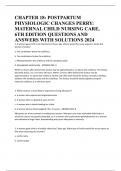Exam (elaborations)
CHAPTER 18: POSTPARTUM PHYSIOLOGIC CHANGES PERRY: MATERNAL CHILD NURSING CARE, 6TH EDITION QUESTIONS AND ANSWERS WITH SOLUTIONS 2024
- Course
- Institution
CHAPTER 18: POSTPARTUM PHYSIOLOGIC CHANGES PERRY: MATERNAL CHILD NURSING CARE, 6TH EDITION QUESTIONS AND ANSWERS WITH SOLUTIONS 2024
[Show more]



